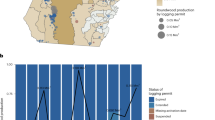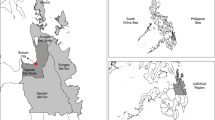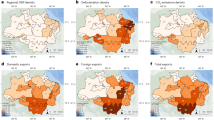Abstract
Forest degradation in the Brazilian Amazon is driven by factors such as fire, mining and illegal logging. The Brazilian government has implemented control mechanisms to combat illegal timber extraction that have positively impacted deforestation rates. Under these regulations, all wood products, from raw logs to processed lumber, must be registered in control systems before transportation. This allows analysis of wood products transported between companies over time. However, the existence of three partially integrated control systems complicates a full analysis of the timber market. This study integrates data from these systems to create timber trade networks, which help identify companies or groups operating outside expected standards. We also propose a method to trace likely supply chains of timber companies, addressing long-standing government concerns about timber traceability. Among the results, we show that certain timber trade networks have components that operate without connections with licensed forests, suggesting that unregistered timber is input into those components, which is illegal. Additionally, we illustrate how supply chain analysis can considerably enhance customer confidence in the legality of purchased timber products.
This is a preview of subscription content, access via your institution
Access options
Access Nature and 54 other Nature Portfolio journals
Get Nature+, our best-value online-access subscription
$32.99 / 30 days
cancel any time
Subscribe to this journal
Receive 12 digital issues and online access to articles
$119.00 per year
only $9.92 per issue
Buy this article
- Purchase on SpringerLink
- Instant access to full article PDF
Prices may be subject to local taxes which are calculated during checkout



Similar content being viewed by others
Data availability
The SINAFLOR database is available from the IBAMA public data portal: https://dadosabertos.ibama.gov.br/dataset/dof-transportes-de-produtos-florestais. Data from SISFLORA-PA and SISFLORA-MT were obtained through collaborative agreements with environmental regulatory bodies of Pará and Mato Grosso states and are not publicly available. The integrated transportation data for Ipe obtained as a result of this work are available via GitHub at https://github.com/lgnonato/Timber-Chain. Owing to the terms of the agreement made with the regulatory body of Mato Grosso, the released data do not include timber companies and transportation in the Mato Grosso state. For possible access to the complete dataset, please contact www.imaflora.org/.
Code availability
The code to build the TTN of Ipe and compute supply chains is available via GitHub at https://github.com/lgnonato/Timber-Chain.
References
Barlow, J. et al. Anthropogenic disturbance in tropical forests can double biodiversity loss from deforestation. Nature 535, 144–147 (2016).
Nobre, C. A. et al. Land-use and climate change risks in the Amazon and the need of a novel sustainable development paradigm. Proc. Natl Acad. Sci. USA 113, 10759–10768 (2016).
Pearson, T. R., Brown, S., Murray, L. & Sidman, G. Greenhouse gas emissions from tropical forest degradation: an underestimated source. Carbon Balance Manag. 12, 3 (2017).
Ellwanger, J. H. et al. Beyond diversity loss and climate change: Impacts of amazon deforestation on infectious diseases and public health. An. Acad. Bras. Cienc. 92, e20191375 (2020).
Lapola, D. M. et al. The drivers and impacts of Amazon forest degradation. Science 379, eabp8622 (2023).
da Silveira Bueno, R., Marchetti, L., Cocozza, C., Marchetti, M. & Salbitano, F. Could cattle ranching and soybean cultivation be sustainable? A systematic review and a meta-analysis for the Amazon. iFOREST 14, 285–298 (2021).
Gatti, L.V. et al. Increased Amazon carbon emissions mainly from decline in law enforcement. Nature 621, 318–323 (2023).
Brancalion, P. H. et al. Fake legal logging in the Brazilian Amazon. Sci. Adv. 4, eaat1192 (2018).
Chen, B. et al. Modeling illegal logging in Brazil. Res. Math. Sci. 8, 29 (2021).
Franca, C. S., Persson, U. M., Carvalho, T. & Lentini, M. Quantifying timber illegality risk in the Brazilian forest frontier. Nat. Sustain. 6, 1485–1495 (2023).
Conama Resolution No. 497, 19 August 2020 (Conama, 2020); https://conama.mma.gov.br/index.php?option=com_sisconama&task=arquivo.download&id=796
Deklerck, V. Timber origin verification using mass spectrometry: challenges, opportunities, and way forward. Forensic Sci. Int. 3, 100057 (2023).
Finer, M., Jenkins, C. N., Sky, M. A. B. & Pine, J. Logging concessions enable illegal logging crisis in the Peruvian Amazon. Sci. Rep. 4, 4719 (2014).
Cormen, T. H., Leiserson, C. E., Rivest, R. L. & Stein, C. Introduction to Algorithms (MIT, 2022).
Eppstein, D. Finding the k shortest paths. SIAM J. Comput. 28, 652–673 (1998).
Acknowledgements
We thank R. Contreras, D. de Almeida, J. Mattos, J. M. Cardoso da Silva and F. Nunes da Silva for their contribution in the early stages of data preparation and database construction. We thank IMAFLORA for its financial and technical support. This work was also partially supported by CNPq (grant nos. 307184/2021-8 (L.G.N.) and 311144/2022-5 (J.P.)), FAPESP (grant nos. 2022/09091-8 (L.G.N.) and 2021/07012-0 (J.P.)), FAPERJ (grant no. E-26/201.424/2021 (J.P.)) and FGV/EMAp (J.P.). The opinions, hypotheses, conclusions and recommendations expressed in this material are the responsibility of the authors and do not necessarily reflect CNPq, FAPESP, FAPERJ and FGV views.
Author information
Authors and Affiliations
Contributions
All authors contributed extensively to the work presented in this paper. V.R., B.C., F.M.-V., G.T. and O.B.d.J. implemented the database integration, wrote the supply chain code and ran most of the experiments. R.V. designed the data integration and collected the SINAFLOR data. M.L., J.P. and L.G.N. designed the experiments and analysed the results. R.V., M.L. and L.G.N. wrote the paper and prepared it for submission.
Corresponding author
Ethics declarations
Competing interests
The authors declare no competing interests.
Peer review
Peer review information
Nature Sustainability thanks Mohammad Reza Ghaffariyan, Franco Perazzoni and Niels Soendergaard for their contribution to the peer review of this work.
Additional information
Publisher’s note Springer Nature remains neutral with regard to jurisdictional claims in published maps and institutional affiliations.
Supplementary information
Supplementary Information
Supplementary Sections 1–3, Figs. 1 and 2, Table 1 and Algorithm 1.
Rights and permissions
Springer Nature or its licensor (e.g. a society or other partner) holds exclusive rights to this article under a publishing agreement with the author(s) or other rightsholder(s); author self-archiving of the accepted manuscript version of this article is solely governed by the terms of such publishing agreement and applicable law.
About this article
Cite this article
Nonato, L.G., Russo, V., Costa, B. et al. Assessing timber trade networks and supply chains in Brazil. Nat Sustain 8, 215–220 (2025). https://doi.org/10.1038/s41893-024-01491-8
Received:
Accepted:
Published:
Issue date:
DOI: https://doi.org/10.1038/s41893-024-01491-8



